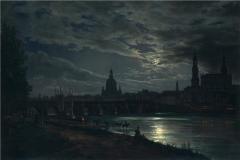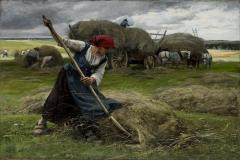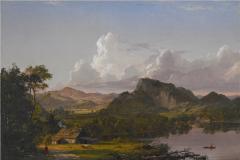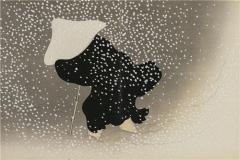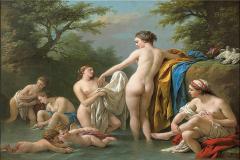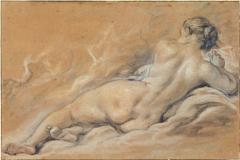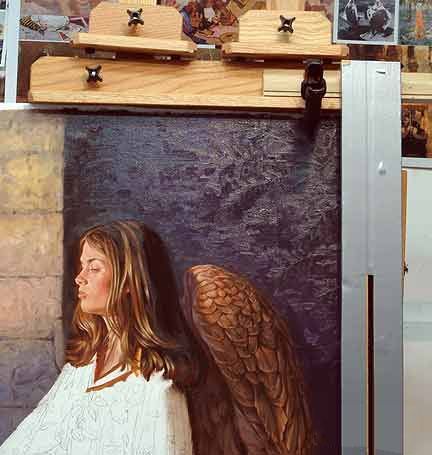
T-square maulstick for vertical and horizontal strokes
The image above shows my little T-Square maul stick I made to allow me to rest my arm and get closer to the wet oil for those tricky refining strokes that need just a touch of swash to refine their edge. It allows me the same freedom that you might find by painting with a water-based medium, like Acrylic, where you can lay your palm down near the area you are working, getting close to the painting. With oils- laying your hand down into wet paint obviously destroys the surface, so making a stable bridge just over the canvas surface gives me the occasional closeness I need for the details. This is just a quick T-square model I made with 2 stips of wood. The top strip has a small lip cut to keep it from falling forward and allows me to slide back and forth and get nice right angles. A traditional maulstick is fine, but I don't like holding it in my left hand where I usually have a cloth rag, like an old towell. Don't use paper towells, by the way, the paper lint invariably gets into the paint surface whereas old t-shirts, diapers or any good absorbent cloth doesn't fall apart and can hold a lot more paint.
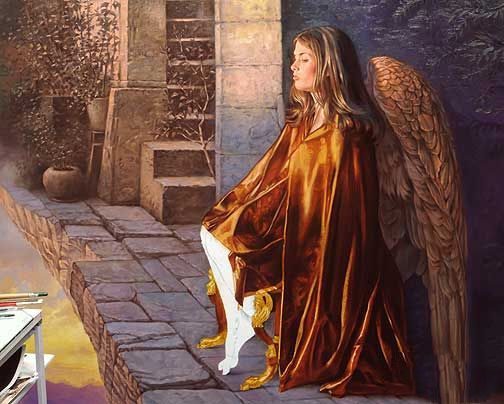
Prefinal
I think I've finally learned my lesson in painting material with patterns on it in oil. Perhaps the best approach for a tonal piece is to paint the larger masses in first then refine it a little until it looks right but has no pattern details. Then leave it alone to dry! I usually try to paint right into that wet area, but its much easier to paint details over the dry surface. I know artists who even redraw with pencil or ink over the dry areas then paint into that. I am somehwere in between by freehanding the pattern with brush and opaque paint, then blocking in the pattern color and refining that. If I was after strick Photo-realism, which I sometimes do for commercial jobs, I would use every method I can think of to get the pattern just right. For my fine art, I think it actually looks better to be a little loose, even off, with the drawing as it gives it more of a personal touch and sets the mood better. I feel this is what the Pre-Raphaleittes often overlooked, allowing finicky detail to dominate a painting and loosing sight of the overall tonal effect. I think there is nothing more boring than stiff, ultra-defined rendering to achieve tight realism. Its something almost anyone can be taught to do, yet the real mood and meaning are often sacrificed. I would much rather see a great illustrated piece by someone like Dean Cornwell who was able to convey emotional scenes like stills from old movies with a bravada style, than any tight realist piece that seems to suggest the emphasis is on the technique rather than what the piece is supposed to be about. My ideal painting is deceptively realistic, convincingly so but not overworked, yet has, on closer inspection, a fluid interesting network of strokes to keep the surface interesting and non-photo like. Its paint, after all! If I can combine that idea or technique with well designed, creative and conceptual imagery then I feel I've done something I can be proud of. I don't know if I always succeed, but this is my intent.
Here is the final. Again, if you read through the demo, I let the first layer dry for around 3 weeks, working on other things. I used a medium that brought back the luster and true color of the dryed layer, in this case Liquin, a viscous gel that has excellent archival properties. It sets up fairly quickly and allows me several hours to paint into it with semi-opaque and opaque strokes with the interntion to refine each area that, simply put, needs work. By sharpening up the edges here and there and trying always for a stroky painterly look, I can literally go over the entire painting in a day. If this begins to dry to the point where its unworkable, I leave it overnight, usually with a fan or air-purifier going to circulate the air. The next day I can go back in and repeat the same approach until I have it where I think its finished. (Bouguereau's main approach, over a brown underpainting or 'imprimatura") This finished quality is more of an instinctual feeling that I have heard from many other artists who know when to stop before they over work their paintings. My illustration background nags at me to keep working on a piece since I know I can bring it to a more realistic, tight level. Thats great for reproduction, but the overworked look is so commercial that I am finally learning to loosen up again and just let the painting live.

